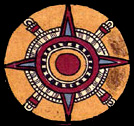Aztec Prayers & Poems Collected By Alarcon
I came across a lovely little hoard of traditional Aztec poems, prayers, and songs the other night. These were originally recored in Ruiz de Alarcon’s 1629 work, Tratado de las supersticiones y costumbres gentílicas que oy viven entre los indios naturales desta Nueva Espana, commonly referred to as “Treatise on Heathen Superstitions” for short in English. For example, he’s posted prayers for safe travel, for love, and even a myth in song about Xochiquetzal and the Scorpion. Professor Joseph J. Fries of Pacific Lutheran University is the person who has generously posted these precious literary treasures, and he includes a bit of commentary as well. Thank you, Dr. Fries!
Greeting The Dawn
“The Sun has come, has risen, the Shining One. How will He fare today? What will He do? Maybe disaster will strike us, His people. O Lord, go and do your noble duty! Bring light to Earth’s Surface!”
Above is my version of one of the traditional Aztec prayers to greet the sun, modeled upon the one recited each morning. (To read the original that inspired this, go HERE and type Tonametl in the “Search in this Book” field. A professional translation of the source prayer is the only hit on page 50, so you can’t miss it.)
Traditionally, a prayer like this was offered right at sunrise, as the Sun, Tonatiuh (literally, “He Goes Forth Shining”), climbed into the sky. It was a daily duty of the priests, and they accompanied their prayer with the beheading of quail, burning copal incense, and possibly autosacrifical bloodletting as well. While the daily offering of quail was generally reserved for the priests and not the general populace, prayer, incense, and autosacrifice were things accessible to all.
The basic structure is simple, and some of its features appear in the longer, more elaborate festival prayers. It has an invocation and a recitation of the god’s name(s), and parallel repetition of phrases. The repetition is a common feature of what was called “lordly speech” in Imperial times, and was a formal style of rhetoric used by nobles and by people addressing the aristocracy. As the Teteo are depicted as the nobility over humans, the same type of formal language is used in prayers addressing them, as all humans would be commoners or macehuales to Them. These techniques combine to show the respect the worshipper has for the gods.
The second half of the prayer consists of contemplation of the future, including the realization that our world is an uncertain, unstable place, and our fortunes could reverse at any time. I wouldn’t be surprised in this context if it is not only a statement of the fragility of mankind, but a subtle plea to Tonatiuh to not be slack in His duties of warming and lighting Tlalticpac (Earth’s Surface). Finally, the prayer closes with a double exhortation to the Teotl to shine with vigor upon the world, the petitioner literally cheering the god on.
If you wish to become more familiar with how the Aztecs composed their prayers and hymns, I recommend visiting my Hymns & Prayers section on the Sacred Texts section of this blog.
Maquahuitl
A quick update today — I came across a link to an interesting little website devoted to the study of the Aztec sword-club, the macuahuitl (also spelled maquahuitl). They even have a new forum for people to discuss traditional Mesoamerican weapons. Cool. Click to visit Maquahuitl, and tell ’em Cehualli sent you. <g>
Library Acquisition: The Codex Mendoza & More
Wow, it’s been a while. Sorry about that. The stuff I’ve been trying to write about kinda pulled a Three Stooges with a narrow door type thing, which was not helped by adding a dash of summer laziness.
Anyway, I’ve had some amazing strokes of luck lately in expanding my library. I’ve acquired a copy of the Bancroft Dialogues, a tough to find Post-Conquest Era volume of Mexica upper class speeches, greetings, and other daily life bits of talking. It’s a significant text because it’s the only early book that has full marks indicating pronunciation, so anyone who wants to learn Classical Nahuatl needs this one. It’s also interesting because it shows how the nobles spoke to their equals and superiors. As the relationship between the Aztecs and their gods was often framed as a noble/subject relationship, I believe the examples likely hint at how they spoke to the Teteo when offering worship. I’m looking for some nice examples to post that people might find interesting.
Another major acquisition has been a copy of the deluxe four-volume Anawalt & Burdan edition of The Codex Mendoza for a stupidly good price. It’s a lovely piece of printing that makes this bibliophile get excited in unhealthy ways. Bound in three quarters Morocco leather, HUGE format, and printed crisply on good alkaline paper, it’s physically well-made. And the info is delightful. There’s a full-color facsimile, a black and white facsimile with parallel text translating the Spanish commentary, and two volumes of essays about the codex and its contents. Very nice! There’s an essay on the honorific warrior uniforms that was particularly interesting and will likely provoke a post at some point. It also gave me a lot of tips on how to spot priests in the codices based on dress and body/face paint.
Lastly, the same gentleman who sold me his copy of the Mendoza just agreed to part with his Dibble & Anderson edition of the Florentine Codex to boot, for a price I never thought I’d see on that set.
The upshot of all this frenzied book-greed for my readers? If you have questions that relate to stuff that’s covered by these texts, I may be able to help. My time’s limited, but so long as it’s reasonable I can try to look something up for you.



